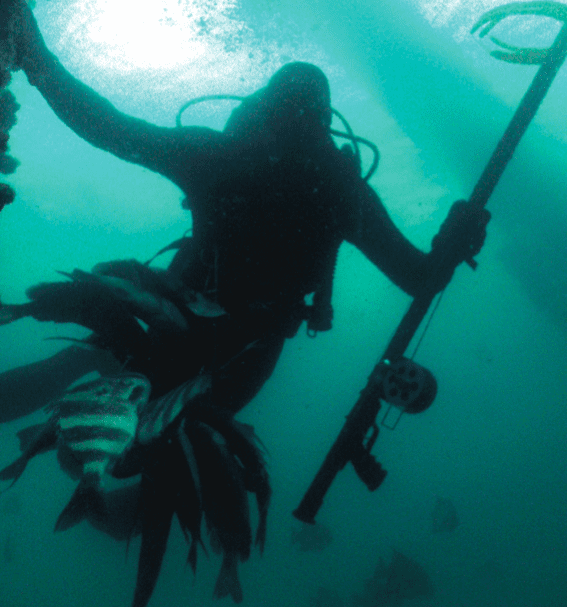[dropcap]M[/dropcap]y type of “spring cleaning” is a mess of sheepshead on the fish-cleaning table. The water is warming quickly and the wind is calming, so more anglers and spearfisherman are starting to venture into the gulf.
Getting the boat out and scrubbing the winter coat of mildew is made easier by the anticipation of the coming season. The talk of the shortest snapper season and stricter limits on other species doesn’t dampen the excitement of the first trip. Some of us have been spearing fish all winter, when the seas would let us escape the dock. For many, their first excursion in 2013 is this month. Besides staring at a wall of red snapper and remaining alert for early cobia, we pass the time underwater stacking up sheepshead.
This is a great fish to target this time of year because their numbers are plentiful. They aren’t a spooky fish that will disappear after shooting 1 or 2, and usually allow for a close shot. They are plentiful for only a few more weeks. I’m not sure if it is because they disburse after mating, or the spring break charter trips wipe the inshore sites clean. Whatever the case, we see them all year but not in large numbers like we do now. Many fishermen believe they are too hard to clean because of their large rib cage. But your friend that is always volunteering to take all your sheepshead is very familiar with the mild flavor and white, flaky meat.
Many underwater hunters think of early spring as the tune-up season. Venturing to the inshore rigs and brushing up on their diving skills and getting their aim back. Just as bow hunters start practicing with backyard targets months before bow season, spearfisherman need to inspect their rigging and practice loading and shooting their spearguns. The difference is, spearguns cannot be shot out of the water at land targets. The only way to practice is to get out and dive…thus the big attraction of sheepshead in March. April usually hosts the first wave of migrating cobia. As soon as the gulf waters reach the magic 68F, we start seeing cobia on the inshore sites. Early spring divers are always scanning into the distance, hoping to see a curious cobia head your way.
The smaller size and liberal creel limits on sheepshead make them a great fish for new spearos to develop their hunting skills. Once a diver has honed his diving skills, many look to add a camera or speargun to their dive plan. Since spearing fish can be challenging and even dangerous in extreme cases, we encourage new hunters to begin with small species and work their way up to the big boys like amberjack and cobia. The challenge of wrestling the large fish isn’t an issue with the smaller fish. I have never heard of a diver being towed around by a 6lb. sheepshead!
Call Gulf Coast Divers at (251) 342- 2970 and ask about dive training and spearfishing. Training can be completed in a couple weeks and you can be geared up and ready for this season. A good scuba system costs about the same as a set of golf clubs or tennis lessons. But if you are like me, then you understand the real fun happens in salt water! So don’t keep saying, “One day I’m gonna’ see what’s down there.” Make that “One day” happen this year.
For a list and directions to all the local dive sites and freshwater springs, call Gulf Coast Divers at (251) 342-2970. Don’t let your dive skills get rusty this winter. Sheepshead season is right around the corner and it will be spring before you know it.

